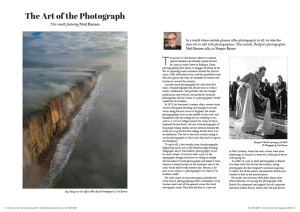In a world where mobile phones offer photography to all, we take the time out to talk with photographers. This month, Bridport photographer Neil Barnes talks to Fergus Byrne.

The proof of Neil Barnes’ efforts to capture special moments are liberally spread around his shop in South Street in Bridport. From photographing John Major or Maggie Thatcher in the 80s to capturing iconic moments around the Jurassic coast, Neil’s dedication to his craft has produced work that now graces the walls of hundreds of homes and businesses around the country.
A professional photographer for over forty-five years, Neil photographs the Dorset coast as well as events, conferences, and portraits. He also designs publications and websites and produces brochure photography. But his career as a photographer started somewhat by accident.
In 1976, he borrowed a camera after a severe storm caused widespread flooding and damage to coastal towns along the east coast of England. He recalls photographing ‘boats in the middle of the road’ and remembers that the college he was studying at was used as a ‘sort of refugee centre’ for some of those displaced by the floods. He also took photographs of the people taking shelter and his lecturer decided the work was so good that the college should show it in an exhibition. This led to the local council asking to use the photographs to show how they had to cope in an emergency.
To top it off, a few months later, the photographs helped him land a job at the Peterborough Evening Telegraph, and as Neil reflects, photography wasn’t his main subject. It had just been a part of the typographic design course he was doing at college. He had taken O Level photography and failed it twice because it leaned heavily on the academic side of the craft, which didn’t really interest him. Hence, as he puts it, his career as a photographer was ‘kind of by accident, really.’
His early career at local newspapers included the usual trail of photographing events, retirements, local business news and all the general stories that local newspapers cover. That then led him to a new job in West London, where the news stories were more interesting. As he puts it, there was ‘really good newsy stuff going on’.
An offer of a job as chief photographer at British Gas then took Neil all over the country, taking photographs for the company’s in-house magazine, as well as for all the events and initiatives British Gas wanted to feed to the national press.
He recalls one occasion when John Major, then Prime Minister, was posing for photographs with British Gas chairman and original ‘fat cat’ corporate executive Cedric Brown. Major and Neil had known each other when he was MP for Huntington. ‘Is that you Neil?’ Major exclaimed, having not seen him for years. A bit of friendly banter caught the eye of Cedric Brown, who joked that British Gas should put Neil on their lobbying committee. It was an amusing interlude but didn’t result in an increase in Neil’s salary.
In 2001, he decided to go freelance, working in Public Relations for a range of different clients. However, his personal life was not easy. One of his three daughters had been born with significant brain damage, and his wife left the family home in 2003, leaving Neil to care for his three children. In time, his two younger daughters left home to go to university, and he decided to move to Bridport, where his sister lived. ‘There’s so much going on here,’ he says, ‘better than the murky Midlands.’
But it was a challenging time. ‘It took some doing to uproot me and my daughter,’ he says. With ‘complex needs’, things like home care, respite and moving from one health authority to another left him with many ‘hurdles to jump through.’ But he did it and says it’s the ‘best thing’ they ever did.
Neil’s interest in landscapes began unexpectedly after a job photographing electric buses in Poundbury. During the drive home, he stopped at Eggardon Hill and took what he says was his first-ever landscape photograph. He remembers ‘watching fingers of light, almost like dancing across the land’ for over an hour. The moment sparked a new direction in his career. His work is now a favourite in the community, especially his Bridport calendars, which have become part of people’s Christmas list. So much so that he often gets people coming into the shop in the new year joking that they didn’t get one for Christmas, so they have to buy their own.
Steeped in photographic history, Neil’s shop in Bridport once belonged to the photographer Claude Hyder and was later known as Pinns Photographic Shop, where many locals will remember getting their passport photographs done. He has spotted a couple of coincidences that add to the serendipity of running the shop. Neil moved to Bridport from Kettering and has discovered that Claude Hyder also moved to Bridport from Kettering. He also tells me that Pinns was opened in the year of the coronation of Queen Elizabeth II in 1953, while Neil opened the latest incarnation of the shop in the year of the coronation of King Charles III in 2023. He is proud to keep this legacy alive, enjoying the happy coincidences that surround the venture. ‘People have said it’s absolutely right that you’ve made it into a photography place again,’ he says.
Despite his success, Neil faces modern challenges, especially with the changing retail environment. So much work is purchased online in our modern shopping world that it’s hard to imagine a shop selling photographs being successful. But customers are still coming in, and the personal touch, as well as being able to see work close up, is a huge bonus for buyers.
But Neil is also embracing technology. He occasionally uses a drone to get unusual angles and has experimented with AI in his work to create animations from still images. One of his most iconic images of a wave crashing over Burton Bradstock beach became the source image for an AI experiment as he created a moving image of the wave. ‘I’m amazed at the result’, he says. ‘Whilst there is quite a bit of negativity around AI, I think as long as the person posting it is honest about its creation when asked, then we should embrace it in the artwork.’
Maybe one day, that sort of moving image could be cost-effectively used for wall hangings, but could that detract from the use of still images? ‘I don’t think it ever will’ says Neil. ‘I think there’s always been room for true, original, “taken in the moment” pictures.’
He is also active in the local community and committed to improving accessibility. Inspired by personal experiences, he’s worked on projects to make local beaches more wheelchair-friendly. ‘I’ve become a bit of an advocate for making the place more accessible’ he says. Wheelchair-friendly beach access is complicated due to the changing surface of beaches, but Neil has campaigned and raised money to install wheelchair-friendly benches at West Bay and Burton Bradstock.
Neil’s shop in Bridport’s South Street not only displays his art but it also connects the past and present, reflecting his own life’s path. It’s about capturing the everyday moments, whether they’re lasting landscapes or fleeting water splashes.
But Neil’s legacy is more than photography; it’s about community, shared histories, and simple moments. ‘It’s great for the ego when people come in and say, I follow you online. I love what you do,’ he says.
Neil Barnes’ story is one of passion and perseverance. Whether recalling his newspaper days or thinking about the next community project, he finds stories worth telling, one photo at a time.




